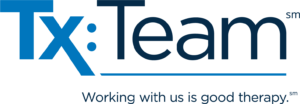Growing with Tx:Team: Amanda Bancroft’s 16-Year Journey of Leadership and Learning
Amanda Bancroft never set out with a specific plan to join Tx:Team—her clinical rotation there was randomly assigned. But what began as a convenient placement close to home has grown into a 16-year career defined by personal growth, leadership, and a deep appreciation for the power of teamwork.
“I feel like I grew up here,” Amanda says. From student to rehab aide, to licensed physical therapist assistant (PTA), and now into a leadership role, Amanda has experienced nearly every aspect of the rehab continuum. “Walking the walk” across different roles has shaped her into a leader who truly understands the people she supports.
Amanda was initially drawn to physical therapy through her background in sports and a strong desire to help others. While communication, especially with physicians and other authority figures, was an early challenge, her confidence grew with experience. She learned to view everyone as equals working toward the same goal: better patient outcomes. “I realized we are all just human and it doesn’t matter your title, your background, or your position. What matters is that we’re all here for this common purpose, and that’s to make the patient better. And so, once I gained that experience, it was just a no-brainer for me,” she shares.
That mindset now guides her leadership. Rather than seeing her role as leaving behind the hands-on care she loved, Amanda sees her current position as another way to care for patients. By streamlining processes and advocating for her staff, she helps improve inpatient rehabilitation care at Frederick Health Hospital every day. She shares, “Knowing I can remove barriers for these clinicians to provide better care is really rewarding for me.”
Though she began her career as a PTA, Amanda now leads a multidisciplinary team, including speech-language pathology and occupational therapy professionals. Complementing her clinical experience, Amanda also holds a business degree, strengthening her ability to manage teams and operations effectively. While it was a learning curve at first, Amanda welcomed the challenge. “It’s been a really fun ride to be taught by my peers,” she says.
Amanda has found inspiration and guidance in those around her throughout her career at Tx:Team. One leader who made a particularly lasting impact is Carroll Nelligan, Chief Operating Officer. “Carroll will always have a special place in my heart,” Amanda says. While she has leaned on many individuals for support, it’s her team that stands out most. “I believe people are put into your life for a lot of reasons,” she shares. “Even difficult interactions have taught me what not to do. My team has taught me things I’ll never fully be able to express.”
Why has she stayed for 16 years? Amanda doesn’t hesitate: “Because I’m not bored. I challenge myself every day, and I know what I’m doing is positively impacting other human beings.” She also credits the company’s leadership for creating a culture that values both quality care and people. “It doesn’t feel like it’s only about the money. They really do care about metrics and outcomes.”
As she looks to the future, Amanda hopes for continued improvements in technology and insurance reform that supports better patient care. But no matter what comes next, her journey at Tx:Team stands as a testament to growth, resilience, and the power of believing in both your mission and your people.
